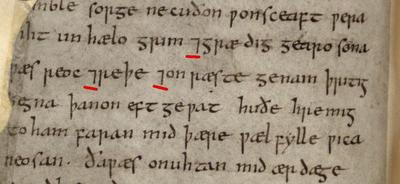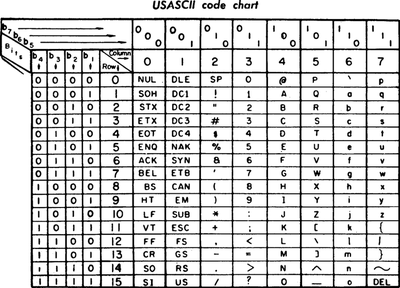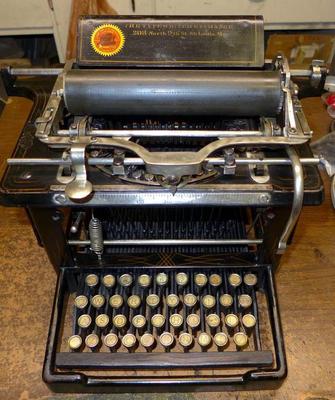Of typewriters, runes, and short-hand
Or, why is the & on the 7 key?
Back in ca. 2003, when I was preparing the diplomatic edition of Beowulf for Beowulf on Steorarume (heorot.dk), I noticed the use of what looks like the Arabic numeral ‘7’ for and (Old English ond).
Beowulf f.132v: ll.120b-123a

wiht unhælo
grim ⁊ grædig gearo sona wæs
reoc ⁊ reþe ⁊ on ræste genam
þritig þegna
The unholy creature,
grim and greedy, soon was geared-up,
wild and savage; and seized from their sleep
thirty thanes
This turned out to be a Tironian et (⁊) , one of a number of
shorthand symbols devised by Marcus Tullius Cicero’s slave and
ppersonal secretary Tiro in the first century which continued to be
used by monastic scribes in the medieval period. The more familiar
abbreviation of et “and” is of course the ampersand &, which,
unlike ⁊, is in fact a stylised et. (For more discussion of some
of the back history of both the ampersand and the Tironian et see
these Shady Characters posts.)
Other shapes of the Tironian et

The fact that the Tironian et ⁊, a shorthand ‘quick’ symbol like
the ampersand &, looks like an Arabic numeral 7 makes the
appearance of the & above the 7 (i.e. as the shifted value of the
7) seem significant. At the time of creating the diplomatic web
edition of Beowulf I assumed that this must be the reason for the
particular placement of the & on keyboards.
Unsurprisingly, other people have thought of this as well, including a StackExchange question (as well as a comment on a Shady Characters post on ampersands). There the ‘accepted answer’ to this question says:
Although the
7was the ampersand on IBM’s standard keyboard layout, that is hardly universal. The first nine printable characters in ASCII are!"#$%&'(), which should give a good clue as to what the top row of a teletype keyboard looked like. On many early teletypes and terminals (and also, BTW, on the Apple ][), the shift key toggled bit 4 of the character being produced, thus it would turn a1(011 0001) into!(010 0001), and,(010 1100) into<(011 1100). Since the digits 1–9 received consecutive code, so did the characters produced by combining them with the shift key.Shift-7on those keyboards was apostrophe; the ampersand wasshift-6.Other typewriter keyboards also varied considerably in where they put the ampersand. Its association with the number
7is nowhere near as consistent as the association between1and!,3and#,4and$, or5and%which existed in both older computer keyboards and today’s US arrangement.

The association of ! (‘bang’) with 1 actually has a fairly tidy
explanation as many of the early typewriters omitted the numeral 1
and the typist was expected just to use the lowercase letter l in
its place; likewise the ! was omitted and was also typed using the
lowercase l then backspacing and typing a full-stop ..
While ASCII and older computer keyboards may not provide evidence for
early association of 7 and &, an examination of the early
typewriters from antiquetypewriters.com reveals firstly that almost
all of the early typewriters collected there which have symbols as the
result of ‘shifted’ numerals do in fact place & with the 7
including the 1892 Norths typewriter (London), Wagner Typewriter Co’s
(New Jersey) 1896 Underwood 1, the 1898 Shimmer (Milton,
Pennsylvania), Meiselbach Typewriter Co.’s (Kenosha, Wisconsin, USA)
1901 Sholes Visible, and, secondly, and crucially, the 1878 Remington
Standard Model No. 2 (New York) also positions & as the shifted
value of 7. The Remington Standard No. 2 is described as the first
commercially successful typewriter, and its (QWERTY-style) layout thus
became established as standard.
Remington Standard No. 2


The one early typewriter I found with shifted numerals as symbols which
didn’t associate 7 and & is the 1895 Waverly (London) where the
& is above the 6 and the 7 has a / above it.
So an association between & and 7 for keyboard does seem to have
been established in the 19th century, presumably through the success
of the Remington Standard No. 2. The question then shifts to whether
or not the placement of the & above the 7 by the designers of the
Remington Standard No. 2 was motivated by Tironian sensibilities or
not.
The Tironian et has disappeared from most everywhere, excepting in
modern Irish typography. Interestingly, some Irish typewriters place
the Tironian et ⁊ above the 7 key.
Keith Houston at the Shady Characters website suggests that:
the Tironian notes suffered near-extinction in the Middle Ages, victim of a curious linguistic witch hunt. The secrecy and cipher-like nature of both traditional runic writing and shorthand did not sit well with the distrust of witchcraft and magic prevalent in those times, and Tiro’s system fell out of use.
Indeed, in Old English manuscripts, runes sometimes appear, standing in for the words which are borne by the particular runes as names, including ᛗ (mann “man”), ᛞ (dæg “day”), and ᛟ (œþel “ancestral land”). The last of these is used three times in the extant text of Beowulf.
Beowulf f.141v: ll.520–521

ðonon he gesohte swæsne ·ᛟ·
leof his leodum lond brondinga
then he sought his own sweet ·ancestral homeland·
– loved by his people – the land of Brondings
In any event, what of the question of “why is the & on the 7 key?”
It would seem in all likelihood that the placement of the & on the
7 is a happy accident. Outside of Ireland, Tironian ⁊s would have
been long enough out of fashion that it seems unlikely anyone (or, at
least, typewriter engineers) would have associated & with 7. The
positioning of the Tironian ⁊ above the 7 key on some Irish
typewriters, on the other hand, is then doubly predestined, given the
largely standard positioning of the semantically-equivalent & over
the 7 on many typewriters and the similarity in appearance of the
Arabic 7 numeral and the Tironian ⁊ symbol.